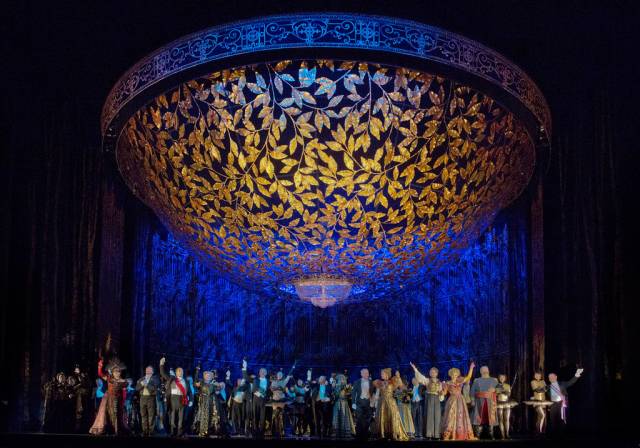

Die Fledermaus brings Johann Strauss, Jr.’s valentine to the turn of the century to The Metropolitan Opera.
Die Fledermaus originally premiered in Vienna in 1874, and had its Met premiere in German in 1905. This year’s Jeremy Sams production is in English, with lyrics by Sams and dialogue by Douglas Carter Beane. Large gold portraits in the first act draw us into an evocative world, complete with lush, red fabrics and a Christmas tree. With Gabriel Von Eisenstein needing to spend five to eight days in prison for speaking badly about a public official, it promises to be a holiday to remember.
Jeremy Sams has kept humor in this delightful show. Susanna Phillips as Rosalinde, who stumbles through her affairs, is bright and captivating, an enchanting lead actress who embraces comedy. Toby Spence's Eisenstein is similarly quick-witted, and lively performances are also delivered by Mark Schowalter as Dr. Blind, Paulo Szot as Dr. Falke, and Alan Opie as Frank.
It’s rare to see a Metropolitan Opera production with so much spoken dialogue. Douglas Carter Beane’s words are clever and keep the audience on their toes, making the entire show a surprising listen. Conductor James Levine leads with grace, bringing out the full sound of the horns and all the lightness of the violins.

Act II keeps the splendor of the operetta. With glittering ball gowns designed by Robert Jones, there is both glamour and intrigue. Also the set designer, Jones provides an astonishing amount of coherence to this intelligible production, with scenography that carries us across time. The enormous gold leaf chandelier above is an astonishing reminder of the glory of Vienna. With all the black and gold, the set seems so heavy, but the performances are so light. It strikes a nice balance. Choreographer Stephen Mear builds a stunning turn of the century spectacle with Russian dancers.
The strong mezzo-soprano Susan Graham leads a great celebration as Prince Orlofsky. The other lead characters slowly appear in disguise, as the dancers twirl with a sense of frivolity. As a large turntable moves in a circle, encompassing the wide stage, cabaret girls with golden skin and short, black skirts parade, and two dancers raised on a chandelier wave their arms.
The third act breezes by. An actor bursts through the fourth wall in improvisation, speaking directly with the audience. As the leading characters feel that they are now - not only in a prison, but a prison production - their mood is light but less frivolous. They realize that there is more champagne, as they bring in the 1900s.
Die Fledermaus lifts the heart beyond tragedy. It is a holiday must-see for fans of this operetta.
Performances of Die Fledermaus continue through January 7. For more information and tickets, visit https://www.metopera.org/